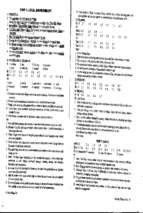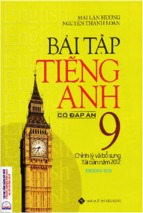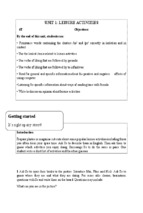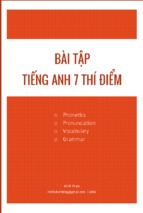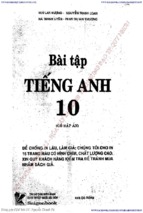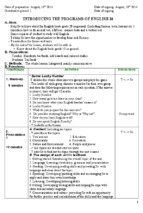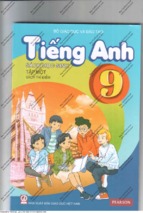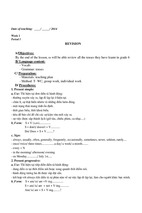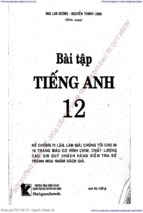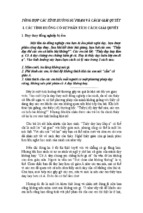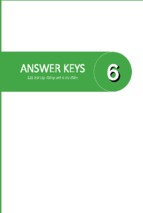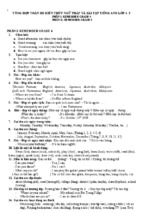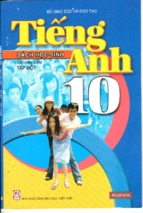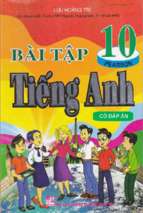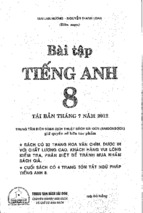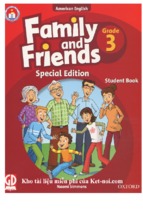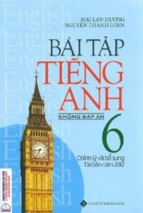Lesson plan English 11
Unit1: Friendship
Period1 Reading
I. Objectives
By the end of the lesson, Ss will be able to:
- Develop such reading skill as scanning for details, specific ideas, skimming for
general information, and guessing meaning in context
- Use the information they have learnt to discuss the topic
II. Teaching aids
Textbook, handouts, pictures concerning to the topic……..
III. Anticipated problems
Ss may need help with discussion task so T should be ready to help them
Ss may have difficulty in reading some difficult words such as:sympathy, loyalty,
suspicion,enthusiasm ………….
T may not have enough time to teach
IV. Procedure
Teacher
1. Check the attendance(2m)
2. Warm up(4m)
Network
T repairs a hangout with network of the word
“friendship”
Friendship
T divides the class into 8 groups and gives
each group a hand out. T asks Ss to complete
the net work. The winner will be the group
completing the network in the shortest period
of time
A. Before you read(10m)
Discussing the picture and poem
T asks the whole class to look at the picture on
page 12 and asks them some questions:
1. What are girls and boys doing in the picture?
2. How do they feel?
3.What does the picture tell you?
T ask Ss to work in pairs to read the short
poem on the page13 and answer the question:
What do you think of the friend in the poem
english 11
1
students
Group work
Discuss about the qualities which
friendship must have to complete the
network
Suggested answers:
Honest,unselfish,constant,loyal,mutual
trust,sympathetic,patient…..
Pair work
Suggested answers
1. One boy is playing guitar, and the
other girls and boys are singing
2. They seem very happy because we
can see their smile
3. The picture tells us that friends can
happily do many things together or
friendship is a beautiful thing that
brings happiness to us
Lesson plan English 11
T calls on some Ss to answer the questions. T
may give some comments and the suggestions:
The friend in the poem is very dedicated and
thoughtful. He/She is willing to help his/her
friend in any circumstances
Pre- teaching vocabulary
Lasting(a)= lifelong
Be concerned with sb/st
Constancy(n)constant(a)
Rumour(n) ['ru:mə]
Gossip(n): information talk or stories about
other people’s private lives that may be unkind
or not true
Incapable of/ in'keipəbl/
Suspicion(n)/ sə'spi∫n/ suspicious(a)
Pursuit(n)
Sympathy(n) ['simpəθi], sympathetic(a)
[,simpə'θetik/
Sorrow(n)/ 'sɔrou/= sadness
T asks Ss to make some Ss to make sentences
with above words to check their understanding
Have Ss practice reading the vocabulary
B. While you read
Setting the scence
You are going to read a passage about the
qualities of a long lasting friendship. While
you reading, do the task in the textbook
Task1 (6m)
T asks the Ss to read the words in the box then
fill each blank with one of them
Ask Ss to read the passage quickly and stop the
lines that contain these words to guess their
meaning
T asks Ss to work individually to do the task
T goes around to help them when necessary
T asks Ss to exchange their answers with the
other Ss
T asks Ss for their answers and tell then to
explain their choices
Task 2(5m)
T asks Ss to read the passage again and decide
which of the choices A,B,C,or D most
adequately sum up the ideas of the whole
passage
english 11
2
Dedicated(a)tËn t©m, tËn lùc
Thoughtful(a)chu ®¸o, quan t©m
Circumstance(n)hoµn c¶nh, t×nh
huèng
L©u dµi, bÒn v÷ng
Quan t©m tíi ai, c¸i g×
tÝnh kiªn ®Þnh
tin ®ån
chuyÖn ngåi lª ®«i m¸ch, chuyÖn
tÇm phµo
kh«ng ®ñ kh¶ n¨ng
sù nghi ngê
sù nghiÖp, sù theo ®uæi, ®am mª
sù th«ng c¶m
th«ng c¶m, ®ång c¶m
nçi buån
do as T‘s requests
whole class
individual work & pair work
Ss guess the meaning of the word base
on the context in the sentences
1. mutual
2. incapable of
3. unselfish
4. acquaintance/ friend
5. give -and -take
6. loyal to
7. suspicious
Whole class read the text carefully
Individual work
Lesson plan English 11
T gets Ss do the task individually
T might also want to give Ss some strategies to
find the main idea of the passage
T calls on some Ss to give the answer and asks
other Ss to say whether they agree or disagree
Task 3(10m)
Ask Ss to answers the questions in task3
T asks Ss to do the task individually to do the
task, then discuss their answers with their
partner
T calls some Ss to write their answers on the
board and ask them to explain their choices
Correct answers:
1. The first quality for true friendship is
unselfishness. It tells us that a person who is
concerned only with his/her own interest and
feelings can’t be a true friend
2. Because they take up and interest with
enthusiasm, but they are soon tired of it and
they feel the attraction of some new object
3. The third quality for true friendship is
loyalty. It tells us that the two friends must be
loyal to each other, and they must know each
other so well that there can be no suspicions
between them
4. Because if not people can’t feel safe when
telling the other their secret
5. Because they cannot keep a secret, either of
their own or of others’
6. The last quality is sympathy. It tells us that
to be a true friend one must sympathise with
his/her friend. Where there is no mutual
sympathy between friends, there is no true
friendship
C. After you read(6m)
Ask Ss to work in pairs to discuss the question
in the text book
T goes around to help the Ss when necessary
When all pairs have finished, T asks every two
pairs to share ideas
T calls on some Ss to report their ideas to the
class
english 11
3
Answer: B
Individual work and pair work
Pay attention then give remark
Correct themselves their mistakes
Pair work
The friendship is very important to our
life. A true friend can helps us when
we are sorrow and when we have
difficulty. We can share ideas,
feeling, likes,joys, pleasures,aims
….to each other. Sometimes only true
friends can understand, sympathise us
so we feel safe to tell him/her our
secrets. Friendship brings us
happiness. We happily do many things
together.So we can’t live without
friendship
Lesson plan English 11
Whole class
4. Homework(2m)
Learn by heart all of new words and structures
and give examples
Summarise the main points of the text
Period 2: Speaking
I. Objectives
By the end of the lesson Ss will be able to
Describe the physical characteristics and personalities of their friends, using appropriate
adjectives
II. Teaching aids
Textbook, handouts, pictures about some famous people………….
III. Anticipated problems
Ss may not have enough vocabulary to talk about the topic, so T should be ready to
provide help
IV. Procedure
teacher
1. Check the attendance(2m)
2. Warm up(5m)
Ask Ss to describe one of their friend or their
relatives
3. New lesson
A. Presentation(10m)
Task 1
Ask 1 S to read aloud the title and explain
Instruction: You are going to look at the picture
of 4 people on page 15 and describe them in
pairs
Before letting Ss do the task, T ask them to read
useful language on page 16
T may explains some word if Ss don’t know the
meaning of the adjectives provided
Forehead(n)/ 'fɔ:hed/: T points at his/her
forehead
Crooked(a)/ 'krukid/
T may ask Ss to provide some
english 11
4
students
Do as teacher’s request
Pair work
Whole class
Tr¸n
Mòi kho»m
Whole class use hangouts to
describe
1. The boy is about 16. He is
Lesson plan English 11
adjective/expressions used to describe
people’Ss appearance. She may also give Ss
handout of these adjectives and expressions:
Height :tall,short, medium
Build : slim(m¶nh kh¶nh), plump(bô bÉm,
®Çy ®Æn), overweight, thin.muscular/
'mʌskjulə/(v¹m vì), stocky(thÊp vµ ch¾c),
well-built(lùc lìng)
Hair:
-length: long, short, shoulder- length
-style: straight , wavy, curly,crew-cut(®Çu cua)
-color: black,grey, red, brown
Others: a fringe(m¸i), a bun(bói tãc), plait(s)/
plæt/®u«i sam
Face: oval, round, large, square, skinny/ ['skini]
(gÇy nhom,gÇy tr¬ x¬ng), chubby(phóng
phÝnh), long, with high cheekbones(gß m¸ cao)
Eyes: small, big, black, brown, blue
Nose: straight, crooked, turned-up(hÕch), big,
small, flat(tÑt)
Chin: pointed chin(c»m nhän),double chin
Lips: thin, full, narrow, heart-shaped
Forehead: broad, high
Skin:white,pale/peil/(t¸i, xanh x¸m),
suntanned(r¸m n¾ng),dark, brown, black
General appearance:beautiful,
handsome,pretty,good looking, plain(b×nh thêng)
T asks to work in pairs to describe the people in
the picture, and then calls on some Ss to present
their answer
T gives feedback
short-sighted because he’s
wearing apair of glasses. He has
short black hair, a round face with
a broad forehead, a small
nose,thin lips and small chin. He
quite good-looking
2.The girl is about 14. She’s also
wearing a pair of glasses. She has
shoulder-length black hair, and
she’s wearing a ribbon(bêm tãc).
She has an oval face with a
straight nose, full lips and a
pointed chin. She quite pretty
3. The man is in his forties. He’s
tall and well-buit. He has short
brown hair and a square face with
a broad head, small eyes , a
crooked nose and thin lips. He
quite good looking
4. The woman is her twenties.
She’s quite tall and slim. She has
long curly brown hair and an oval
face with a broad forehead, big
eyes, a straight nose heart-shaped
lips and a small chin. She’s very
beautiful
Whole class and group work
B. Practice(10m)
Task 2
Ask Ss to discuss and number the personalities
in order of importance in friendship and then
report the results
Before Ss do the task, T asks them to look at
the list of adjectives provided in book. T asks if
Ss understand these adjectives or not
T can elicit [i'lisit](luËn ra,gîi ra) or explain
some adjectives quickly
Caring
Hospitable
english 11
5
Chu ®¸o
HiÕu kh¸ch
Khiªm tèn
Ch©n thµnh
Th«ng c¶m, th«ng hiÓu
Group work
1st group: My group thinks that
Lesson plan English 11
Modest
sincere
understanding
T divides the class into group of 6 with a group
leader. They discuss and the leader will take
notes of the ideas, and then one representative
will report the result to the whole class. T
reminds Ss that they have to explain their
choice as well
T goes round to offer help when Ss discuss
T call on some Ss to report the result of their
discussion.
T elicits feedback from the class and gives final
comments
C. Production(15m)
Task 3
Instruction: Imagine that you have a friend
who has just won the first prize in Mathematics.
A journalist is going to interview you about
your friend. Act out the interview in pairs
T asks Ss to look at their role on page 16 anf
the suggestions on page 17
T may elicit the questions they may ask
-his /her hobbies: What does he/she like doing
in his/her freetime?what are his/her hobbies
-his/her physical characteristics: what does he/
she look like?
His/her personalities:How is he/she?Is she/he
friendly...?
T may also make clear the meaning of some
adjectives
Quick-witted
Good-natured
T asks Ss to work in pairs to perform the
interview in 7 minutes and goes around to offer
help
T call on some pairs to perform the interview
T elicits feedback from the class and gives final
comments
4. Home work(3m)
Write down a paragraph to describe your best
friend
Prepare the next period”listening”
english 11
6
being caring is the most important
in friendship because when
friends care about eachother, they
will know when to share
happiness or difficulty with their
friend…
Pay attention
Nhanh trÝ
Tèt bông
Pair work
Whole class
Lesson plan English 11
Period 3 Listening
I. Objectives
By the end of the lesson Ss will be able to
Develop such listening micro-skills as intensive listening for specific information and
taking notes while listening
II. Teaching aids
Textbook, handouts, cassette tapes………….
III. Anticipated problems
Ss may not be familiar with the note-taking task,so T should provide them some tips to
deal with the task
IV. Procedure
teacher
student
1. Check the attendance(2m)
2. Warm up(5m)
Matching
The aim of this activities is to help Ss revise the
vocabulary items Ss learnt in the previous
lesson
T divides the class into small groups of 3-4
students
Then T distributes the following crossword
hand out for Ss to do in their own groups.
Which group finishes first and has all the
correct answers will be the winner
A
B
1. good-natured
a,Nhanh trÝ
2. friendly
b, Hµo phãng
3. quick-witted
c, HiÕu kh¸ch
4.hospitable
d, Hay gióp ®ì
5. patient
e,Khiªm tèn
6. honest
f, Ham häc
7. generous
g, Kiªn nhÉn
8. helpful
h,ThËt thµ
9. modest
i, Th©n thiÖn
english 11
7
Whole class
Group work
1. j
2. i
3. a
4. c
5. g
6. h
7. b
8. d
9. e
10. f
Lesson plan English 11
10. studious
j, Tèt bông
3. New lesson
A. Before you listen(10m)
Talking about your best friend
- T asks Ss to discuss the questions on page
17 in pairs
- T calls on some Ss to give their answer and
comments on the answer
- T gets Ss what they are going to listen about
Vocabulary pre –teaching
- Before teaching the new words, T helps Ss to
pronounce the words given in the book. T may
read aloud first or play the tape and ask Ss to
repeat in chorus and individually
- elicits/teaches some of these word and those
taken from the listening passage
Apartment building:
Sense of humour:
Give sb a ring: phone sb
Go though a rough time:
- T may get Ss to make sentences with the
words and give corrective feedback
B.While you listen
Task 1(10m)
Instruction: You are going to listen to Lan and
Long talk about their best friends. Listen and
decide whether the statements are True or
False. Put a tick() in the appropriate box
Before Ss listen and do the task, T instructs
them to use some strategies
+ First, read through the statements to
understand them and underline key words. For
example, the key words in the first statement
are: shared, Nguyen Cong
Tru, Residential Area, Hanoi……..
+ Listen to the tape and pay attention to the key
words
+ Decide whether statements are true or false
based on what they can hear
- T plays the tape once for Ss to do the task
- T asks for Ss’answers and writes them on
the board
- T plays the tape the second time for Ss to
check their answers
- T asks Ss to work in group 4 to compare
english 11
8
Pair work
Whole class
Toµ nhµ cã nhiÒu c¨n hé
KhiÕu hµi híc
Gäi ®iÖn cho ai
Tr¶i qua thêi kú khã kh¨n
Pay attention
Individual work & Group work
Lan’s talk
1. F(They used to live in the
same buiding there)
2. F( It is what people think)
3. T
4. F( Lan went to Do Son first
and then called Ha, so Ha rode
on her mortorbike to Do Son to
meet Lan)
5. T
6. F( They have been best
friends since Lan’s trip to Do
Son)
Lesson plan English 11
their answers
- T checks Ss’ answers by calling some Ss
and asks them to explain their answers
Long’s talk
1. F( They met in college)
2. F ( Minh was a guitarist)
3. T
4. T
5. T
Whole class
Task 2(7m)
Instruction: You are going to listen to the tape
again and fill the table in the book with notes
-T plays the tape again for Ss to complete their
notes.
- after playing the tape, T gets Ss to work in
pair and check their answers
- T calls on some Ss to give the answers. T
provides correct answers if necessary. If Ss
cannot comple the task, T might let Ss listen
one more time and pause at the answers for
them to catch
Suggested answers:
Individual work and then pair
work
Listen to the tape carefully and
fill the table in the book with
note
How and where did they meet?What do
they like about their friends?
Lan
- They used to
live in the same apartment building in HN
- Lan went on a holiday in Do Son and Ha went
there to help her
- Ha’s very
friendly and helpful
- Ha’Ss sociable. She’s got many friends in Do
Son and she introduced Lan around.
Long
- They met in
college
- Minh played the guitar, and Long was a singer
- They worked together
- Minh has a
sense of humour
Pair work
- Minh likes to go to plays and movies
- Minh is a good listener
- Minh is friendly and helpful
C. After you listen(8m)
- T asks Ss to work in pairs to talk about how
Ha has been Lan’s best friend and how Minh
has been Long’s best friend
- T goes around to offer help and correct Ss’
mistakes
english 11
9
Whole class
Lesson plan English 11
- T calls on some pairs to present their answers
- T elicits feedback from the class and give final
comments
4. Home work (3m)
Ask Ss to learn by heart all new words and
prepare the next lesson “ writing”
Tapescript:
Lan’s talk
My best friend is Ha. We’ve been friends for a long time. We used to lived in Nguyen
Cong Tru Residential Area in HN. Her family moved to Hai Phong in1985. It is said
that HP people are cold but Ha is really, really friendly. I first started to get to know her
when I was going on a two-day trip to Do Son last year and didn’t know anybody there.
I gave Ha a ring and she was so friendly, she said. “ Oh, I’ll come to visit you”. So she
rode on her motorbike to Do Son and twenty minutes later she was there. She stayed
with me for two days. She happened to know a lot of people there, so she introduced me
around and we’ve been best friends ever since.
Long’s talk
My best friend is Minh. We met in college. And I was there singing and Minh was a
guitarist. So we worked together a lot, but we also became friends. Minh has a great
sense of humour, he’s very,very funny, and that’s of my favourite things about him.
And over the years, we have been through good times and bad times with each other,
and that’s one of the things I like best about him. And we have a lot of the same
interests. We like to go to plays and movies together. But when we’re going through a
rough time, he’s really a good friend, and he’s a very good listener, and he always
helped me though.
Period 4: Writing
I. Objectives
By the end of the lesson Ss will be able to:
Write about a friend, real or imaginary, using the words and expressions that they have
learnt in previous lesson
II. Teaching aids
Textbook, handouts, ………….
III. Anticipated problems
Ss may not have sufficient vocabulary to write about the topic, so T should be ready to
help them
IV. Procedure
Teacher
1. Check the attendance(1m)
2. Warm up(6m)
Guessing game
T introduces the game: 1 student goes to the
board and T gives him or her a piece of paper
english 11
10
Students
Group work
Ss may ask questions such as:
Lesson plan English 11
with the name of a student in the class. Other Ss
have to ask Yes/No question to find out who
students is. Ss should ask about the appearance,
personalities, or clothes….
- The game can continue until the time is up.
A. Before writing(13m)
- T sets the scene: You are going to write about
a friend, real or imaginary, using the provided
guidelines
- T gets Ss to read the task and the guidelines
silently and work out what they are required to
write about. In general, Ss’ writing should
include 3 parts:
+ general information about about their friend
+ his/her physical characteristics and
personalities
+ and what Ss like about the friend
T elicits the verb tenses that may be useful
when Ss want to write about when and where
they met their friend. In this case, Ss may use
the simple past tense and past continuous in
their writing.
T revises the use of the past tense and past
continuous tense
T may also elicit the adjectives and expressions
Ss can use to describe their friend’s appearance
and personalities
T gets Ss prepare an outline for their writing
and exchange it with their peer(partner)\
T goes around to offer help and gives corrective
feedback
B. While writing(15m)
T gets Ss to write about their friend in
15minutes
T goes around to observe and offer help
C. Post writing(8m)
T ask Ss to exchange their writing with another
Ss for correction
T goes around and collects mistakes and errors
T collects some writings for quick feedback
T writes Ss’ typical errors on the board and
elicits self and peer correction. T provides
correction only when Ss are not able to correct
the errors
english 11
11
Is the person a girl?
Is she tall?
Is she short- sighted?
Is she friendly?
…………..
Whole class
Pay attention
Individual work
Pair work and whole class
Whole class
Lesson plan English 11
Finally, T provide general comments on the
writings
4. Home work(2m)
Ask Ss to improve their writing, taking into
consideration their best friends’ and T’s
suggestions and corrections
Ask them to prepare the next period: ‘language
focus”
Period 5: Language focus
I. Objectives
By the end of the lesson Ss will be able to:
-Distinguish the sound /dʒ/ and /t∫/
- Pronounce the words and sentences containing these sounds correctly
- Use some structures containing infinitives with and without to appropriately
II. Teaching aids
Textbook, handouts, ………….
III. Anticipated problems
Ss may find it difficult to pronounce the two sounds, so T should prepare a lot of
practice
IV. Procedure
Teacher
Students
1. Warm up(3m)
Noughts and Crosses
Hospitable Honest
Around face
Caring
Sense of humour Friendly
Large
Good-natured
Pleasant
2. New lesson
A. Pronunciation(10m)
-Pronouncing the two sounds separately
-T models the two sound /dʒ/ and /t∫/ for few
times and explains the differences in
producing them
/dʒ/: is a voiced palatal
Voiced=vocal cords vibrate while making this
sound
Palatal= put your tongue behind your top teeth,
push air as you drop your tongue away from
the roof of your mouth
english 11
12
Group work
-Listen attentively
-Tell the difference
©m vßm miÖng h÷u thanh
D©y thanh ©m rung lªn khi ph¸t
©m
Listen and take note
Lesson plan English 11
/t∫/ is an unvoiced fricative palatal
Unvoiced- vocal cords do not vibrate while
making this sound
Fricative palatal = touch your tongue to the
back of your upper teeth and pull your tongue
away as your push air out of your mouth
T plays the tape once for Ss to
hear the works containing these
two sounds. Then T plays the
tape again and this time asks Ss
to repeat after the tape
Pronouncing words containing the sounds
-T reads the words in each column all at once
/dʒ/:jam, joke, January, dangerous,passenger,
village
©m v« thanh: d©y thanh ©m
kh«ng rung lªn khi ph¸t ©m
©m vßm miÖng phô ©m x¸t
Repeat after the tape
-/dʒæm/, /
dʒouk/, /dʒænjuəri/, /deindʒrəs/,
'pæsindʒə/, /vilidʒ/
/t∫/:children, changeable, cheese, mutual,
church , which
-T reads the words once again, each time with
a word in each column to help Ss distinguish
the differences between the sounds in the
words
- T reads the words and asks Ss to repeat them
- T asks Ss to practice pronouncing the words
in pairs
-T goes around providing help
- T asks some Ss to pronounce the words and
give correction if necessary
Practicing sentences containing the target
sounds
- T reads the sentences and asks Ss underline
the words with the sound and write /dʒ/
and /t∫/ under them
-/ 't∫ildrən/,/
't∫eindʒəbl/,/t∫i:z/, /'mju:tjuəl/,/t∫ə
:t∫/, /wit∫/
- T asks Ss to provide the sentences in pairs
-T goes around providing help
- T asks some Ss to read the sentences and
gives feedback
B. Grammar and Vocabulary
1. To infinitive (10m)
- T writes some sentences on the board and
underline the to+ infinitive
+ I have letters to write to my friends
+ I have some homework to do
+ Does he get anything to eat?
Practice reading the sentences
which contain 2 sounds
english 11
13
Practice reading
Pay attention
Lesson plan English 11
+ Have you got anything to say?
- T asks Ss to comment on the use of to +
infinitives in these examples. T reviews the
form and use of to –infinities in the example
- The infinitive can be placed after
nouns/pronouns to show how they can be used
or what is to be done with them
+ I have letters to write = I have letters that I
must write……
+ I have some homework to do= I have some
homework that I must do
+ Does he get anything to eat?= Does he get
anything that he can eat?
N/pro+to -infinitives
Ex: I need someone to take care of my
children
to -infinitives + prepsitions
ex: I need someone to talk to my mother
Can I borrow your case to keep my records
in?
Adj + to -infinitive
Too/ enough + to –infinitive
Practice
Exercise 1
Ask Ss to do exercise1 individually and then
compare their answers with another student
- T calls on some Ss to read aloud their
answers
- T gives the correct answers
2. Infinitive without to(10m)
- after “make, let”+object +bare infinitive
- after verbs of perception such as: feel, hear,
watch, see, notice, observe, smell+object
+bare infinitive
Ask Ss to give some examples
Listen and ask the other to comment
Practice
Exercise 2
-T asks Ss to do exercise 2 in pairs. Ss have to
english 11
14
-Give their opinions
- In the examples above the
infinitives are used to replace
relative clauses
Give more examles
Take notes
I pleased to see you
Ex: The water is too hot to drink
He’Ss old enoughto go to
school
Individual work
1. Who wants somethings to eat
2. I have some letters to write
3. I am delighted to hear the news
4. My mother has some shopping
to do
5. You always have too much to
talk about
6. It’s lovely to see you again
7. It’s too cold to go out
8. I’m happy to know that you
have passed the exams
Ex:Nothing can make him cry
I see her cook
dinner(completed action)
Notice:I see her cooking dinner(I
see she’s cooking dinner)
Pair work and then individual
work
1. The police watched them get
Lesson plan English 11
rewrite the sentences by using the words given
-T asks them to compare answers with another
pairs
-T calls on some Ss to go to the board to write
their answers
- T asks other Ss to feedback and gives correct
answers
Production(10m)
Extra exercise
Join these pairs of sentences
1. she crossed the road. I saw her
2. They sang a song. I heard them
3. He looked the door. I observed him
4. She drove off. I saw her
5. He was foolish. He left the firm
6. A pavement artist drew a portrait in crayons.
I watch him
7. We can’t refuse their invitation. It would
look rude
8. I met you again. I was happy
9. The film was boring. I didn’t watch it
10. The woman is old. She can’t drive a car
3. Homework(2m)
Learn by heart all the knowledge they’ve
learnt and practice them again at home
Prepare the next lesson:unit 2 : reading
out of the car
2. They let him write a letter to
his wife
3. I heard them talk in the next
room
4. The customs officer made him
open the briefcase
5. The boy saw the cat jump
though the window
6. Do you think the company will
make him pay some extra money?
7. I felt the animal move towards
me
8. Do you think her parents will
let her go on a picnic?
Whole class
1. I saw her cross the road
2. I heard them sing a song
3. I observed him lock the door
4. I saw her drive off
5. He was foolish to leave the firm
6. I watched a pavement artist
draw a portrait in crayons
7. It would look rude to refuse
their invitation
8. I was happy to meet you again
9. The film was not interesting
enough for me to watch
10. The woman is too old to drive
a car
Whole class
Unit 2: Personal experiences
Period 1 Reading
I. Objectives
By the end of the lesson Ss will be able to:
english 11
15
Lesson plan English 11
- Develop such reading skills as scanning for details, specific ideas, skimming for
general information, and guessing meaning in context, identifying the sequence of
events
- Use the information they have learnt to discuss the story
II. Teaching aids
Textbook, handouts, cassette ………….
III. Anticipated problems
Ss may need help with discussion task, so T should be ready to help them
IV. Procedure
Teacher
1. Check the attendance(2m)
2. Warm up(5m)
Ask Ss some questions and ask Ss to answer
- when was your last birthday?
- What did you do on that day?
- How did you feel on that day?
- What did your parents offer you?
3. New lesson
A. Before you read(5m)
-T introduce the pictures:
The six pictures describe the events in a story.
They’re not in chronological order. Can you
describe what’s happening in each of the
picture
- T suggests for the Ss by asking some
questions:
+ What do you see in the 1st picture?
+ What do you think might be relationship
between the girl and the man?
+ What do you see on the table?
……………………………………….
Vocabulary
Floppy cotton hat
Wad of dollar notes
B. While you read
Set the scene: you are going to read a story in
which a girl’s telling about her most
embarrassing situation
Task 1(10m)
-T asks Ss to reads the passage silently and do
the task1
-T writes the given words and phrases on the
board:
To make a fuss
english 11
16
Students
Whole class
Answer the questions
Whole class
A man and a young girl
May be they are family members
It’s money
Mò v¶I mÒm
TËp tiÒn
Pay attention
Read the passage in silently
Guess the meaning of the words
G©y ån µo, Çm Ü
lÐn lót
to look quickly at st/sb
making you feel nervous,
ashamed, or stupid: lóng tóng,
Lesson plan English 11
Sneaky(a)
Glanced (at)
Embarassing(a)
xÊu hæ
someone you admire and adore
Idol(n)
- T asks Ss to go back to the passage to locate
and read around these words
- T checks that Ss understand all these words
correctly by calling on some Ss to tell the
meaning of the word in Vietnameses
- Then T asks Ss to go back to the task and
study the given sentences
- T asks them to fill the blank with the words/
phrases in the box
- T checks the answer with whole class
Task 2(5m)
- T asks Ss to read the text silently again and
then with a peer work out the sequence of the
pictures given on page 22 again
- T calls on a student to give and explain his/
her answer
Task 3 (10m)
- T checks if Ss can answer the comprehesions
in task3 without having to read the passage
again. If Ss can not, T gets them to read the
questions carefully and gives them some tips
to do the task
- T gets Ss to check their answer with a peer
- T calls on some Ss to write their answers on
the board and asks them to explain their
choices
C. After you read(6m)
Ask Ss to look at the last picture(c) and give
suggestions
+ How did the girl in the picture feel?
+ Why did she feel that way?
+ What did she do after that?
- T calls on the group to tell and explain their
choice
english 11
17
1. glanced
2. making a fuss
3. ambarassing
4. idols
5. sneaky
Individual work& pair work
1. picture d 2. picture b
3. picture f 4. picture e
5. picture a
6. picture c
Individual work then pair work
1. A floppy cotton hat
2. to buy the hat for herself
3. A wad of dollar notes that
looked like the ones her father
had given
4. Because she didn’t like to
make a fuss
5. She bought the hat with it
Group work
1.She felt surprised/ ambarassed
Because the money she took
from the boy’s bag was not hers
2. Perhaps the girl might want to
tell her father the truth and ask
him for help. Perhaps the girl
could come to the police station,
tell the police the truth and ask
them for help
May be the girl could get on the
same bus the next day and look
for the boy to return him the
money
Lesson plan English 11
Whole class
- Then T asks Ss to summarise the main points
of the lesson
4. Homework(2m)
Summarises the main points of the lesson
again
Learn by heart the new words and make
sentences with them
Whole class
Period 2 Speaking
I. Objectives
By the end of the lesson Ss will be able to:
- Identify structures that are used to talk about past experiences and their influences on
one’s life
- Practice the present perfect and past simple, structures with “Make”
- Use these structures to talk about a past experience and how it affects their life
II. Teaching aids
Textbook, handouts, ………….
III. Anticipated problems
Ss may have problem using present perfect and past simple when talking about the past
IV. Procedure
Teacher
1. Check the attendance(2m)
2. Warm up(5m)
Ask Ss some questions about their experiences
- Have you ever sung in the public?
+ When did you sing in the public?
+ How did you feel ?
+ How did the experience affect you?
- Have you ever failed the exam ?
- Have you ever got a bad mark?
………………………..
3. New lesson
Task 1(10m)
- T introduces the task and gets Ss to do it
individually then compare the answer with a
partner
- Call on some Ss to read out his/her answers
english 11
18
Students
Whole class
Answer the questions
Yes, I have
On Teacher’s Day
I was all in a tremble(run)
Since then I haven’t been afaid
of singing in the pubic
……………………….
Individual work and pair work
1. d 2. c 3. a 4.b 5.e
Appreciate(v): Coi träng, ®¸nh
gi¸ cao
Lesson plan English 11
- T checks with the class and gives feedback
- T introduces the structures:
Make sb do smt/make sb+Adj
Ex: The flu makes me stay at home/ The flu
makes me tired
Task 2(15m)
- T introduces the task and ask Ss to work
individually then compare the answer with a
partner
-Notice Ss some about how to use past simple
and present perfect simple
+ Present perfect: used with “ever” to ask
about past experience:Have you ever been to
England?
+Past simple: used when one keeps asking
about that experience: When did you go there?
Who did you go with?...
- After finishing T gets Ss to read the sample
conversation in pairs
- 0pen dialogue:
A – Have you ever………….?
B – Yes,…………..English girl……..
A – How…….meet………..?
B –………..walking along………asked the
way…….started talking……..
A – What………talk…….?
B – Everythging……….name,
……..turtles……….
A – How……affect………?
B – Well,………more interested……….
- Call some pair Ss to practice the D then give
marks
Task 3(10)
- T introduces the task: using suggested
questions on page 26 to ask and answer the
questions about their past experiences
- T calls on some pairs to perform their
conversations in front of the class
4. Home work(3m)
Learn by heart the dialogue
english 11
19
To change your attitude to
sb/st( Thay ®æi th¸I ®é cña b¹n
®èi víi ai hoÆc ®iÒu g× ®ã)
-Give more examples
Whole class
Take notes
1.b 2.d. 3.h 4.a 5.e 6.g
7.c
Pair work
Close the book and practice the
open dialogue
Pair work
Ex: “ be seriously ill”
-what(what disease did you get)
-when(when did you fall)
-how(How did you get ill)
-go to hospital(Did you have to
goto ..)
- how(How did the experience
affect you?)
Lesson plan English 11
Period 3 Listening
I. Objectives
By the end of the lesson Ss will be able to:
Develop such listening skills as listening for specific information and taking notes while
listening
II. Teaching aids
Textbook, handouts,cassette tape ………….
III. Anticipated problems
Ss may not have sufficient vocabulary to talk about the topic, so T should be ready to
assit them. Ss may not also be familiar with the note-taking task so T should provide
them some tips to deal with the task
IV. Procedure
Teacher
1. Check the attendance(2m)
2. Warm up(5m)
Hangouts : Matching
Column A
Column B
1. Fire fighter
Students
Whole class
Group work
Answer
1. c
2.h
3.e
4.a
5.b
6.g
7.d
8.f
2. Fire alarm
3. Fire door
4. Fire escape
5. Fire hydrant
6. Fire extinguisher
7. Smoke
8. Fire struck
a. A metal stair way
outside to help people get out of a building on
fire
b. A pipe that draws water for putting out a
fire
c. A person who fights fires
d. What comes out of a fire
e. A fire-resistant door that can be closed to
stop the spread of a fire
f. A large truck that carries firefghters and
equipment to the side of a fire
g. A tube that contains special chemicals for
putting out fire
english 11
20
Whole class
-A fire
-A house is burning and firefighters are trying to put out fire
- They are fire-fighters
- She is carring her daughter out
of the fire
1. ®¸ng nhí
5. bÕp ga
2. sî h·I
6. «m
- Xem thêm -

